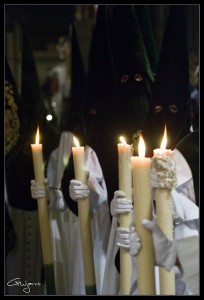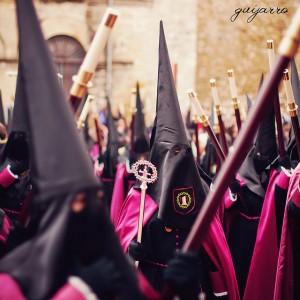The Spanish Holy Week and its frightening garments: the origins of the “capirote”. Posted by Magda on Apr 17, 2014 in Learning, Spanish Culture
Había una vez una bloguera que comenzó a escribir sobre cultura española y a compartir cosas que pensaba podían ser interesantes para gente aprendiendo su idioma. Así que escribió sobre su ciudad, sobre dichos y refranes, literatura, a veces sobre cocina, y por supuesto sobre las distintas festividades de su país. Uno de sus posts iba sobre la celebración de la Pascua en España, que como sabéis es una fiesta muy religiosa. Compartió algunas imágenes, una de ellas del típico penitente, y para su sorpresa y asombro recibió varios comentarios y mensajes preguntando sobre las vestimentas de los nazarenos, ¿podéis imaginar por qué? Porque algunos de sus lectores los habían tomado por miembros del Ku Klux Klan!
Este es el motivo por el que hoy quiero hablaros del origen de parte de esa extraña vestimenta: el capirote. Ese gorro puntiagudo es parte del uniforme de algunas hermandades que salen en procesión durante la Semana Santa. Es un sombrero cónico y largo que cubre el rostro y el cuello de los penitentes y deja dos agujeros para los ojos.
En tiempos de la terrible Inquisición, los condenados eran obligados a vestir un sambenito (un ropaje penitencial parecido a un escapulario) y similares gorros hechos de cartón en actos de fe públicos, como signo de penitencia y humillación. Curiosamente, se les permitía ocultar el rostro mientras imploraban perdón y se enfrentaban a su sentencia. Dependiendo del pecado y su gravedad, el sambenito y el capirote eran decorados con diferentes imágenes, desde cruces de distintos colores a demonios y llamas.
Por suerte hoy día ya no se quema a la gente en la hoguera, pero los penitentes aún mantienen esos ropajes como símbolo de aflicción y arrepentimiento. Así que recordad: a pesar de lo espeluznante que puede ser toparte con uno de estos penitentes en mitad de la noche, no os asustéis, son tan solo pecadores lamentándose.
¿Podréis…?
 images by Juan Carlos Guijarro Moreno
images by Juan Carlos Guijarro Moreno
Once upon a time there was a blogger who started writing about Spanish culture and sharing things she thought that could be interesting for people learning her language. So she wrote about her city, some typical expressions and sayings, literature, cooking sometimes and obviously about different holidays and festivities from her country. One of her posts was devoted to the celebration of Easter in Spain, which as you know is a very religious festivity. She shared some pictures, one of them of a traditional penitent, and to her shock and surprise she received several comments and messages asking about the penitents´ clothing, can you imagine why? Because some of her readers mistook them for Ku Klux Klan members!
That´s the reason why I want to talk about the origin of part of this strange garment: the capirote. This pointed hat is part of the uniform of some brotherhoods that go in processions during the Holy Week. It is a long conical hat that covers the face and the neck of the penitent and leaves two holes for the eyes.
In times of the terrible Inquisition, condemned people were forced to wear a sambenito (a penitential garment similar to a scapular) and alike hats made of cardboard in public actos de fe (acts of faith), as a sign of penitence and humiliation. Curiously enough, they were allowed to hide their faces as they seek for forgiveness and confronted their sentence. Depending on the sin and its gravity, the sambenito and the capirote would be decorated with different paintings, from crosses of different colors to demons or flames.
Fortunately, people are not burnt at the stake nowadays, but penitents still keep this clothing as symbol of grief and repentance, and the shape of the capirote is considered to be their attempt to rise towards heavens. So remember: as chilling as it can be to face one of these penitents in the middle of the night, don´t be afraid, they are just sinners mourning.
So remember: as chilling as it can be to face one of these penitents in the middle of the night, don´t be afraid, they are just sinners mourning.
Could you…?

Build vocabulary, practice pronunciation, and more with Transparent Language Online. Available anytime, anywhere, on any device.




Comments:
Abby:
Yo soy un estudiante y estamos buscando en las celebraciones. La Semana Santa o Triduo Pascua es cuatro dias para nosotros. vNuestros ropas de los sacerdotes no son de miedo, pero se simbolizan con los colores. También cambian cada día. Visten ropas blancas en el Jueves Santo, rojo en el Viernes Santo, violeta el Sábado Santo y el blanco para la Pascua. Siempre hemos celebrado el día con masa.
Magda:
@Abby Hola Abby,
las ropas que describo no las llevan los sacerdotes, sino la gente que sale en procesión (penitentes). También aquí se celebran misas cada día durante la semana.
Jack:
Hola me llamo Jack, soy un estudiante. En los Estados Unidos nos importa realmente tenemos ninguna cosa como esa ropa cuando celebra la Pascua. Pero es muy interesante que esta ropa santos parecen ropa Ku Klux Klan. Me pregunto si hay alguna correlación?
Emily Malzone:
Semana Santa en España es principalmente enfocó en arrepentimiento de pecados y expiación. Desde luego Semana Santa en los Estados Unidos discute pero el concentración es en redención y salvación no los horrores pecado. Pecado no es resalté. No tenemos esa extraña vestimenta. Nosotros solo tenemos las palmas y adoración de la cruz. Es muy interesante discutir y investigar celebraciones religiosos en países otros.
Katherine:
Capitore y el noche de brujas en Estados Unidos. El noche de brujas es más divertido que capitore. Capitore es serio.